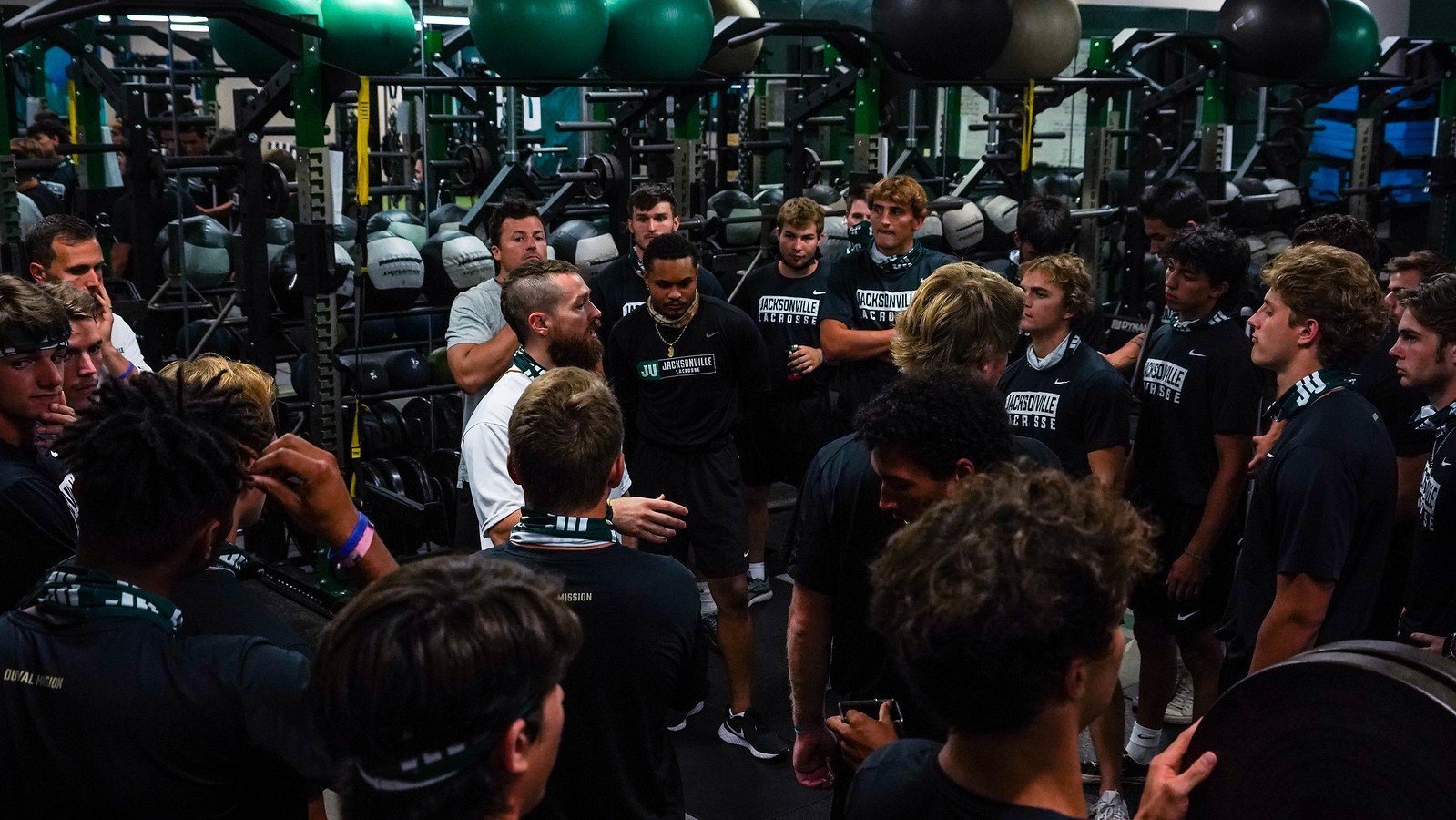There are a multitude of things that go into creating a well-designed training program. In this article we’re going to dive into some of the lesser discussed components that influence team strength training sessions and in many ways affect practical programming decisions more than traditional periodization models do.
Don’t get me wrong, understanding general training principles, the concept of periodization and properly planning your training cycles by thoughtfully laying out your training plan and training goals for a season is vital. This is especially important when training team sport athletes at the collegiate level, where things are constantly changing and resources may vary from institution to institution. However, I often see coaches overlooking the most pragmatic consideration for programming in favor of performing the verbatim set, rep, and intensity guidelines and training order outlined in strength and conditioning manuals. By doing this, not only are you not factoring in your own athletes specific needs or limitations, but you’re essentially trying to shove a square peg through a round hole because by definition those are guidelines, not the rule.
If over a decade coaching in college strength and conditioning has taught me anything, it is that there are no rules. In that amount of time working and testing these ideas at multiple universities, witnessing it firsthand at dozens of others, and speaking with even more colleagues in the profession on the topic, three of the most important things needed to be considered when beginning to program for your current situation is: 1. Facility 2. Equipment 3. Coach to athlete ratio.
Things to consider when beginning to program
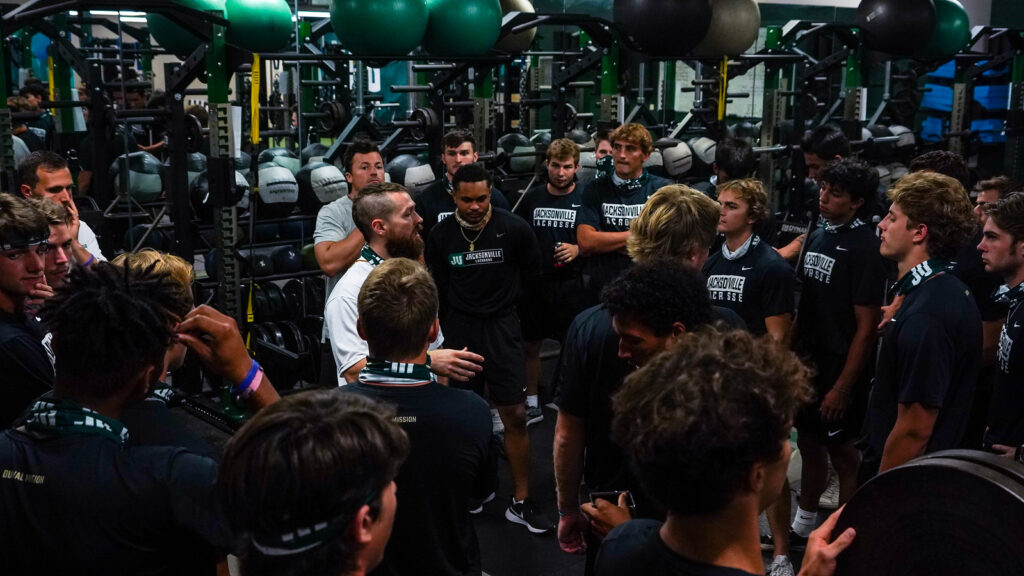
Facility
Not all weight rooms created are equal. Your training facility has different attributes that make an impact in many ways, setting the foundation for how you can effectively program for your teams.
Let’s start with what impacts practical programming in a facility the most and what is least likely to easily be resolved, and that is facility shape. This may come across odd at first but if you have worked in as many facilities as I have and seen even more than your fair share of weight rooms, you’ll know that not all weight rooms are perfectly rectangular in shape. If you have a facility that’s shaped like a ‘Z’ Tetris piece, has large cutouts for balconies, low ceilings, or is curved in some sort of way, you’re going to have to get a little more creative with your programming. This is already a wrinkle that will more than likely veer you off that “ideal” training scenario outlined in some of those sacred training textbooks. Throw in a team of 60 athletes or two teams of 30 simultaneously training during the same time block, bookended by more teams on the hour before and after that session, and you have yourself a recipe for much needed ingenuity and flexibility in your programming to get that new version of “ideal” training accomplished.
Next for programming considerations based on your facility layout is the overall size and the actual trainable space. Facility size certainly does make a difference in how you program as well as effects what you implement in that training session and your decision to even break apart larger teams into multiple training sessions, but overall size is certainly not the end-all-be-all. Coaches can get quite inventive with small spaces and run quality lifts but just because the footprint of a weight room is larger doesn’t necessarily make it a more constructive training space. Facility size and shape really go hand-in-hand. Although it might be personal preference to a coach, I’d argue a smaller square foot facility shaped properly beats a facility double that size with long-narrow corridors, unnecessary pillars, blind spots, or unusable wall areas. There is no doubt that more space simply gives you more options for training. Options such as being able to proactively set-up more of the lift at one time, having floor space to do dynamic warm-ups, or being able to more freely move from area to subsequent area of the room are certainly benefited from additional square footage. However, larger facilities can also affect your line of sight when more equipment is added into the mix, can add to set-up time, and make it more difficult to manage athletes when they’re spread across a bigger facility.
Final considerations for facility is the flow. Again, this will be largely affected by the size and shape of your facility but it is worth mentioning the general pattern your program follows will need to be planned out if the size and/or shape of your weight room has unique qualities. Avoiding choke points in the program where more space of the room is needed, less equipment is accessible or available, or where exercises are overcrowded in one area and athletes are congested in one space can not only waste time but potentially become a safety hazard. Planning your program out to address the flow of your weight room and how the sessions operate from start to finish will definitely help streamline everything, allowing you to accomplish more work in the same amount of time and get more quality out of your work in a shorter amount of time.
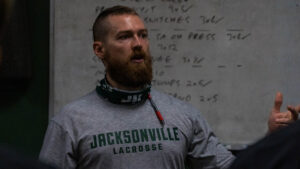
O’Brien talking about the programming for Lacrosse Team at Jacksonville University
Equipment
Similar to facility design, equipment access or lack thereof on the surface level seems common sense when it comes to programming. I want to program trap bar deadlift. Do I have trap bars? No. Can I buy trap bars? No. Ok, no trap bar deadlift. Seems fairly straightforward, and I would agree. However, simply asking whether or not you have the equipment at your disposal is merely scratching the surface when it comes to team programming and effectively running a quality training session. Once you start factoring in the other complexities that go into a full training session, you then have to consider all the constraints that we discussed regarding your facility and how that will affect the group of student-athletes you have coming in to train and therefore how you program for that session.
Not having access to equipment has never stopped a good strength coach. Coaches are nothing if not adaptable when it comes to programming based on limitations not only due to weight room configurations but maybe even more so when it comes to equipment limitations. Coaches have been doing more with less ever since the profession began, and lack of a certain piece of equipment is no different. With that said, there is definitely a tipping point where strength training equipment ingenuity yields to safety and common sense.
I think we can all agree that if you don’t have proper Olympic bars you shouldn’t be trying to do full snatches with a team. If you only have one pair of kettlebells, you shouldn’t be lining student-athletes up to take turns going one at a time making laps around the racks for carries. The point is, the equipment you have access to in your facility, the quantity of that equipment and the space required to safely use that equipment will be impacted by your facility shape, size, and flow.
More equipment should theoretically give you more options for programming. But more equipment with less space becomes a problem just as more space and less equipment can. In conjunction with the training space though, those options can be either reduced or increased based on your facility size, shape, and flow as well as your training philosophy and total number of athletes.
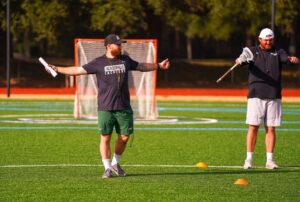
Nick O’Brien taking the session out on the field at Jacksonville University
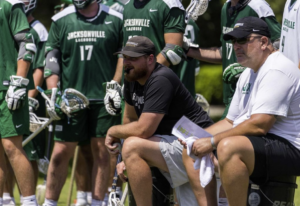
Coach Tyler T. Granelli and Adam Silva on the sidelines of practice with the Jacksonville University Lacrosse team
Coach to Athlete Ratio
Now that the raw material items and training area is settled, it’s time to actually program, right? Not quite. The last piece of the puzzle really boils down to coaching and the athletes utilizing the equipment and space you have access to.
In plain terms the coach to athlete ratio is just that, the ratio of total number of coaches as compared to total number of athletes on the floor at a given time. There are different guidance from both the CSCCa and NSCA organizations but often those numbers at most universities are impossible to uphold due to a multitude of reasons. Now nearly everyone can agree that improving the coach to athlete ratio and having more (qualified and competent) coaches on the floor is a good thing. But for the sake of this article, we’ll save the conversation of improving that number for a different time. For now, let’s dive into some ways that your current coach to athlete ratio influences practical programming.
This coaching athlete ratio can be effective in many ways other than just simply a numbers game. Yes, increasing the number of coaches on the floor available should provide you the ability to get closer to your more “ideal” version of programming because more eyes are on the athletes during the training session. However, as any other seasoned collegiate coach will tell you, it’s much more than simply having more on-looking “coaches” there. Differences in coaching competency (interns, GA’s, full-time, etc.) can influence how programming is constructed. Factor in the training age of the athletes, the space of the facility, the design and flow of the facility, along with the type of training and structure of those lifts and you can see how being able to properly coach each training session effectively becomes more challenging, therefore needs to be properly planned for.
There are many other factors that affect coaching a training session. Can you see the entire space? Can you see all your athletes at once? Can you get to an athlete quickly if you need to give them a coaching cue, spot them, or see something wrong?
There’s a difference in looking at an empty weight room when no one is training in it and it’s uninhabited by any athletes versus what it looks like when you throw a team of 60 let alone two teams of 30 in it at the same time. The amount of space you “lose” when bodies are flying from station to station, weights are being changed, athletes are transitioning to new exercises, athletes are on the floor versus standing, etc. can make any facility seem a lot smaller in a quick amount of time.
Your facility size, equipment at your disposal, and the amount of competent coaches you have available is going to make a huge impact on what you’re able to do in a session and therefore what is feasible to efficiently and effectively program for each session. Those three components collectively will greatly influence what you’re able to do, where you’re able to do it, when you’re able to do it, and in what effect that has on your intended training stimulus as well as ultimate training goals. How you program, what you program, and when you program certain movements or exercises is largely affected by facility, equipment and your coaching ratio. Don’t neglect these things when finalizing your training programs.
Currently Nick O’Brien is the Assistant Director of Sports Performance at Jacksonville University joining the staff in 2021. O’Brien came to Jacksonville by way of Fresno State University where he served as an Assistant Strength and Conditioning Coach since 2016. Prior to Fresno State he was an Assistant Strength and Conditioning Coach from 2014-2016 at Loyola University Maryland as well as spent two years as a Graduate Assistant Strength and Conditioning Coach at Salisbury University. He began his coaching career at his alma mater, Salisbury University, as a volunteer assistant (2009-2012) in addition to completing internships at American University (2015), San Diego State University (2014), Loyola University Maryland (2013),
and Georgetown University (2011).
A native of Oceanside, CA, O’Brien earned his Master’s degree in Applied Health Physiology in 2014 and his Bachelor’s degree in Exercise Science in 2012 from Salisbury University. A member of the CSCCa and NSCA, he currently holds the SCCC, CSCS, FMS, USAW-L1 and USAPL-CC professional certifications.
In addition to his coaching experience, O’Brien is a national level strongman competitor and Highland games athlete. He is a committee member of the NSCA Strongman SIG and the Host of “The Strength Game” Podcast. O’Brien is also a Second Lieutenant in the U.S. Army and currently resides in Jacksonville, FL.
Our Collaborative Planning Process allows you to prepare your project stress free by allowing our team to become your personal project manager. The real-time planning and organization of thoughts gives you back time and clarity as a leader. If you’d like to schedule a FREE CONSULTATION, please fill out this form.
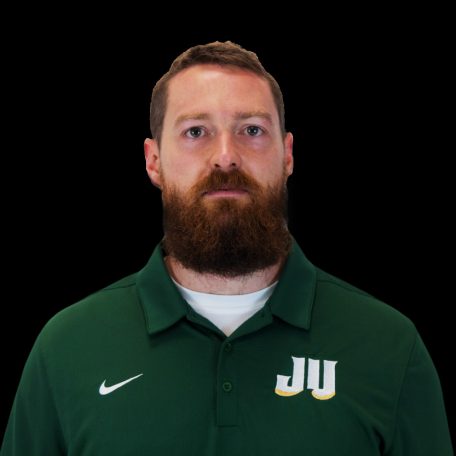
Nick O’Brien
college strength and conditioning coach, national level Strongman competitor and Highland games athlete, and an Officer in the United States Army.
A native of Oceanside, CA, O’Brien earned his Master’s degree in Applied Health Physiology in 2014 and his Bachelor’s degree in Exercise Science in 2012 from Salisbury University. A member of the CSCCa and NSCA, he currently holds the SCCC, CSCS, FMS, USAW-L1 and USAPL-CC professional certifications.
In addition to his coaching experience, O’Brien is a national level strongman competitor and Highland games athlete. He is a committee member of the NSCA Strongman SIG and the Host of “The Strength Game” Podcast. O’Brien is also a Second Lieutenant in the U.S. Army and currently resides in Jacksonville, FL.
Twitter
Youtube
Linkedin
Instagram
Spotify
Email: coachNobrien@gmail.com Website

